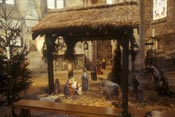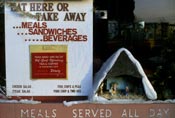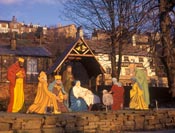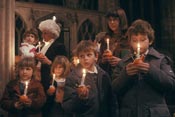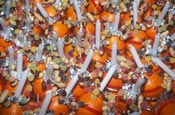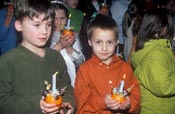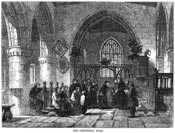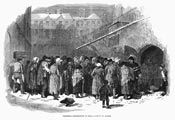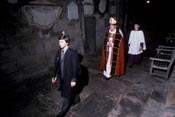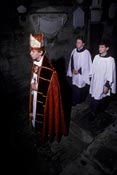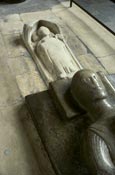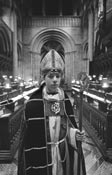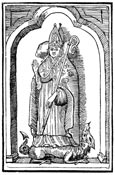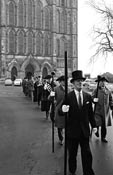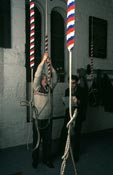
Christmas services are held in every church in Christendom – too widespread for anyone to think of photographing them. But there are ‘church’ customs that are unusual. Cribs are everywhere of course, but the one in Ripon Cathedral has the most remarkable ceramic Holy Family and Three Wise Men that we have seen, while the creation in Baildon is certainly the most fun – though possibly not meant to be.
Christingle was devised in 1747 in the Moravian Church in Germany to explain the love of Jesus to children. The orange represents the world, the red ribbon the blood of Jesus, the sweets the fruits of the earth, and the candle Jesus as the light of the world. Christingle services soon spread all over the Christian world but did not arrive in the Anglican Church in Britain until the late 1960s. Since then it has become an essential part of the Christmas season.
Boy Bishops were common in the Middle Ages until abolished by Elizabeth I. The first major revival in this country was in the early 1970s at Hereford Cathedral, for a special children’s service which proved so popular that the Boy Bishop has been an annual fixture there ever since. More recently there have been other revivals, for instance at Salisbury and Westminster Cathedral. Indeed there are ‘Boy Bishops’ in many parish churches as well - and in these days of equality, ‘Girl Bishops’. Has the Synod heard? However the Hereford ‘Bishop’ is invariably a senior (and impeccably behaved) boy of the cathedral choir, ‘enthroned’ on 6 December, the feast of St Nicholas, and in office until Holy Innocents Day, 28 December. Originally a Boy Bishop performed most of the duties of the real Bishop; nowadays he has to write and preach a sermon and take part in services and cathedral events, especially for children. The position is taken seriously and it is a great honour to be elected.
Christmas Day is one of five ‘Horn Days’ in Ripon on which the famous Hornblower leads the Wakeman (Mayor) and council in procession between the Cathedral and the City Hall. Late on Christmas Eve in Dewsbury the bell ringers ‘Toll the Devil’s Knell’. The tenor bell of All Saints parish church is tolled once for every year since the birth of Christ, starting before 10 o’clock in order to finish exactly at midnight. There is a legend that the bells were donated by Sir Thomas de Soothill in the 15th century as a penance for killing a servant who attended midnight mass on Christmas Eve without permission - but there is also evidence that the custom was observed in other churches in Yorkshire to drive away the devil before the Christmas season. Apparently getting the timing right inside the church is an annual anxiety but there is no denying that the ringing sounds sinister on a wet and windy night.
